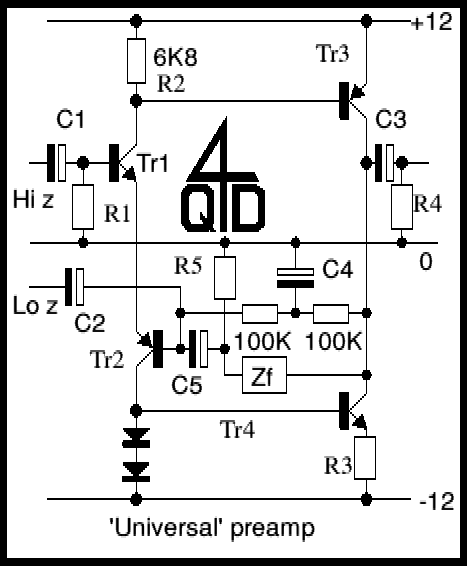Audio preamplifier circuits
There are thousands of pre-amplifier circuits. These are three which have interested me and are a little different.
Intercom preamp
A very convenient way of making an intercom is to use a loudspeaker as a microphone. This is a preamp with a low input impedance suitable for this purpose.

The circuit is so simple that there is little to say about it, but it gives very good results. Tr1 is operated in grounded base mode with input to its emitter to give low impedance input. The values shown give correct operation from 9v. If operating from other voltages you may wish to alter the 1K8 resistor to give symmetrical clipping at high levels.
If you wish to switch the speaker (to use the same speaker as a speaker and as a mic, then you should arrange the switching to short the speaker out before disconnecting it. This is because the d.c. through Tr1 also flows through the speaker so removing the speaker will upset the d.c. conditions and cause a large thump in the speaker. You could of course fit a 1K resistor in the emitter and use a 100µF capacitor to couple the speaker.
High quality microphones also tend to be low impedance, typically around 600 ohms. This is a low input impedance, high quality pre-amplifier of the sort that could be used in a stage mixing desk. In fact that was the purpose for which it was designed, but never used because I soon after left the company.

The circuit uses a dual rail power supply - convenient because there were many op-amps in the machine. Note that Tr1 is a PNP transistor. Theoretically PNP transistors can have lower noise level than NPNs.
Tr2 amplifies Tr1's output. Tr3 is simply a constant current collector load for Tr2, with its current controlled by the 180R emitter resistor. This can be altered to give more current to feed lower impedance output loads.
Overall negative feedback is applied via the 100K pot (log is best) which is the gain control. Note that the feedback loop includes the input and output capacitors so the low frequency response is excellent.
The 150K resistor is present to charge up the input and output capacitors to avoid thumps when inserting/withdrawing a microphone. The voltage across these two capacitors is very small in any case (about 1/2 volt).
You can of course do this with an op-amp. One advantage of transistors is that you can easily change a noisy one. Selecting a low noise op-amp may not be so easy. Also of course most constructors will have suitable transistors. You may not have a suitable low noise op-amp to hand!
Universal high quality preamp
The third circuit is one I was working on as I left the audio company but is seems to be potentially very useful. It should be simple to use it as a low impedance mic amp or as a high input impedance preamp for mic or, with a suitable RIAA equalization, for phono pickup or similar. It can even be used as a balanced input mic preamp.

If you have been browsing this site you may notice that it is the 4 transistor op-amp circuit shown on the index page and at the heart of the low distortion power amplifier.
R1 will define the impedance if the high impedance input - say 100K. R4 charges the output capacitor only. R3 defines the operating current in Tr4, say 1K for 500µA or so.
The feedback paths have been separated: d.c. feedback is via the two 100K
resistors, which are decoupled so they don't affect the a.c. feedback. A.c.
feedback if via the network Zf, which can be RIAA for phono or whatever as
required.






